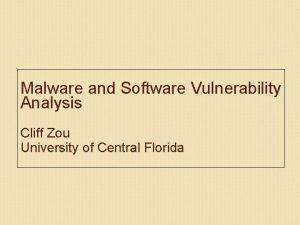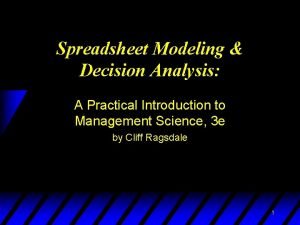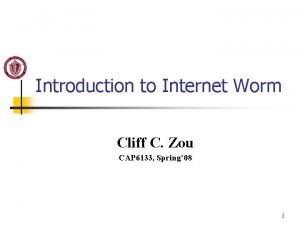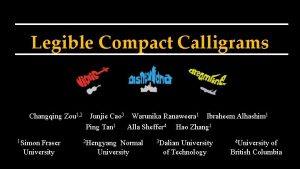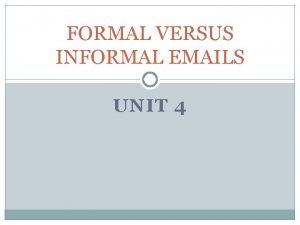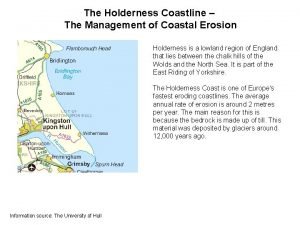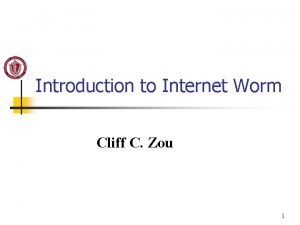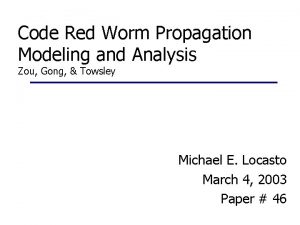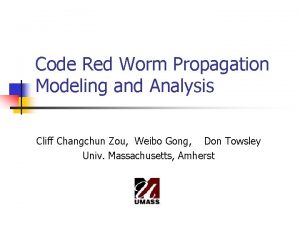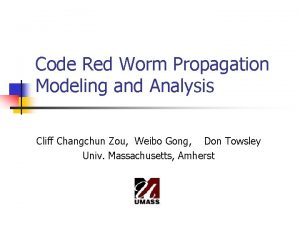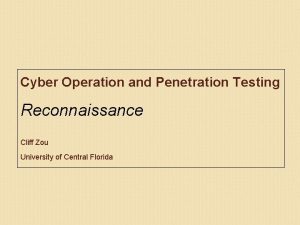Email Worm Modeling and Defense Cliff C Zou














- Slides: 14

Email Worm Modeling and Defense Cliff C. Zou, Don Towsley, Weibo Gong Univ. Massachusetts, Amherst 1

Internet Worm Introduction n Scan-based worms: u n Email worms: Example: Code Red, Slammer, u No human interaction u Blaster, Sasser, … u Example: Melissa, Love letter, Sircam, So. Big, My. Doom, … Human activation § Fast (automatic defense) u Need vulnerability § Slower u § Fewer incidents § Network-based blocking u Modeling: no (week) topological issue u Epidemic models Need no vulnerability § More incidents § Defense on email servers u Modeling: email address logical topology u No math model yet Nimda: mixed infection My. Doom: search engine 2

Email Topology — Heavy-tailed Distributed Complementary cumulative distribution (May 2002: > 800, 000 Yahoo groups) n Email topology degree distr. u u Popular email list: one list address corresponds to many. Email worms find all addresses on compromised computers. Ø n Size distr. of email address books Email address books, Web cache, text documents, etc. We study email propagation on power law topologies. u Generators available ; best candidate to represent heavy-tailed topology. 3

Email Worm Simulation Model n Discrete time simulation n Topology: undirected graph u n Power law, small world, random graph Modeling behavior of individual user u u Worm email attachment opening prob. Email checking time interval Ø n Following any distribution: Exponential, Erlang, Constant. Modeling the entire user population u u normal distr. 4

Propagation Stochastic Effect n n n Power law network: 100, 000 nodes, average degree = 8 Nt : the number of infectious at time t. N 0 = 2 randomly selected 100 simulation runs for each experiment n n Initially infected nodes and initial infection are critical. It is possible that no one is infected except N 0 • When no neighboring nodes open email attachments. Random effect in simulation 5

Initially infected nodes with different node degree Avg. degree = 8 n Avg. degree = 20 Initially infected nodes are more important in a sparsely connected network than a densely connected network 6

Effect of email checking time variability n n Random variable n Exponential n 3 rd-order Erlang n Constant An email worm propagates faster when the email checking time is more stochastically variable. u Snowball effect: Before worm copies give birth to the next generation in the less variable system, worm copies in the more variable system have already given birth to several generations. 7

Topology Effect on Email Worm Propagation Topology effect n Avg. degree of infected nodes (1000 simulation runs) An email worm propagates faster on a power-law topology than on the other two. u u Highly connected nodes are infected earlier. They amplify worm propagation speed by shooting out more copies. 8

Immunization Defense against Email Worms n Static immunization defense: u u n A fraction of nodes are immune to an email worm before its outbreak. No nodes will be immunized during the worm’s outbreak. Selective immunization: u u Immunizing the mostly connected nodes. Effective for a power-law network Ø Nodes have very variable node degrees 3 ~ 2000+ 9

Selective Immunization Defense Power law topology n Small world topology Selective immunization defense is more effective on a power law topology than on the other two. u Due to the percolation property of a topology. 10

Percolation and Phase Transition n Selective percolation with p: u u Removing top p percent of mostly connected nodes. Corresponding to selective immunization. Ø n Newman et al. studied uniform percolation. Selective percolation property: u Connection ratio: Ø u Remaining link ratio: Ø u fraction of remained nodes that are connected. fraction of remained links. Phase transition selective percolation threshold Ø Disjoint the remaining network when 11

Percolation and Phase Transition Power law topology n Why different effect with 5% selective immunization? u u n Small world topology Power law topology: removing 55. 5% links Small world (random graph) topology: removing < 20% links Email worm prevention via selective immunization (Phase transition) : u u 30% for the power law topology Around 70% for the small world and random graph topologies. 12

Summary n n Email topology is a heavy-tailed distributed topology. The impact of a power law topology on email worm propagation is mixed: u u Cons: an email worm spreads faster than on a small world or a random graph topology. Pros: static selective immunization defense is more effective. 13

Future Work n Mathematical modeling u n Difficulty: considering an arbitrary topology Directed graph for email topology u u One-way email address relationship Heavy tailed distr. definition? Topology generator? n Dynamic immunization defense n Short-term focus: Enterprise network defense 14
 Example of basic buffer
Example of basic buffer Cliff zou ucf
Cliff zou ucf Cliff zou
Cliff zou Pharynx function earthworm
Pharynx function earthworm Cliff ragsdale spreadsheet modeling solutions
Cliff ragsdale spreadsheet modeling solutions Helen c. erickson nursing theory
Helen c. erickson nursing theory What are the first line of defense
What are the first line of defense Dimensional modeling vs relational modeling
Dimensional modeling vs relational modeling Wilt u zo vriendelijk zijn om
Wilt u zo vriendelijk zijn om Miyu zou
Miyu zou Animal calligrams
Animal calligrams Yi zhi zou
Yi zhi zou Formal informal email
Formal informal email Holderness coastline
Holderness coastline River cliff and slip off slope diagram
River cliff and slip off slope diagram
